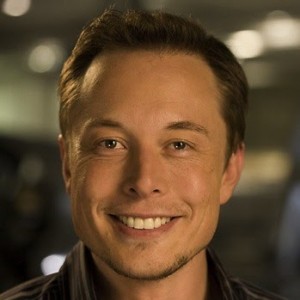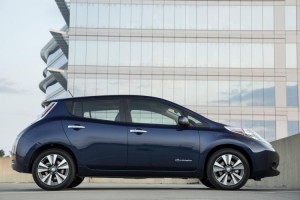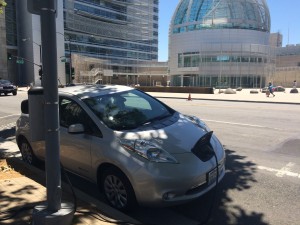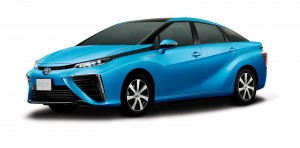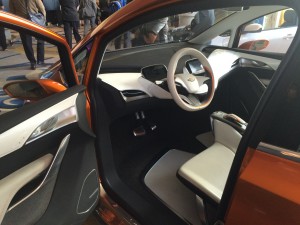The proposed merger between Tesla and SolarCity has a lot of Wall Street types grumbling. But as I wrote a few weeks ago, the deal makes some sense in the short run and has the outside potential for major gains unlike anything we’ve seen in the energy space.
Now the Chicago Tribune spells out some of the specifics of the upside for the company, much of which is predicated on likely policy changes to solar policy in the U.S.:
Net metering rules, which require electric utilities to buy back rooftop solar from customers at retail rates, are the biggest U.S. subsidy for solar power. But as solar power spreads, the policy will begin to destabilize grid economics. Several states have reversed their rules already, most notably Nevada, where the abruptness of the turnabout left customers in the lurch with overbuilt solar systems and no way to recoup costs. Higher-capacity battery storage will eventually allow solar customers to profit from their solar systems with or without net metering. It’s investment security for the homeowner.
Essentially, Tesla is betting — with good reason — that states will likely start encouraging battery installation along with solar panels.
The article also notes that Tesla may be able to aggregate all of its customers’ battery power to sell this flexible resource to the wholesale electricity market to provide various grid services, distributing the revenue to its customers in the form of reduced energy bills or cash payments.
My only quibble is that the “frequency regulation” market that the article cites is lucrative but relatively small. So the company may have better success aggregating all this flexible demand to be responsive to grid needs (essentially to match renewable generation).
So in the near term, Tesla can benefit by selling solar panels in its showrooms. In the medium term, it can bet on battery incentives in many states and the possibility of aggregating all of its customers’ energy resources to sell to grid operators. And in the long run, as costs continue to decline and new technologies become available, the company could very well supplant traditional utilities by managing all of your energy — and transportation — needs.
Not a bad play, all in all.
Occasionally I hear criticisms of the electric vehicle push that we are simply replacing one limited resource (oil) with another (lithium and other raw materials for EV batteries).
Yet knowledgeable people seem to indicate that the resource issue isn’t real and that plenty of materials exist to power the world over with batteries.
Now Bloomberg reports on Tesla’s efforts to lock up the raw materials it needs for its big battery push, with the potential for competition from international actors who also need batteries for their consumer products:
For its batteries, Tesla typically uses formulations including lithium, nickel, cobalt, and aluminum oxide. To find a steady and affordable supply of these materials—key to keeping the base price of the Model 3 at about $35,000—the company is recruiting staffers to scour the globe. It hired Rene LeBlanc, a former engineer at FMC Lithium, earlier this year. It’s also looking for a Tokyo-based supply-chain analyst willing to travel frequently to China and South Korea to work closely with suppliers.
Despite all the buzz about lithium, Musk reminded investors at Tesla’s May 31 shareholder meeting that the metal is “just the salt on the salad,” accounting for only about 2 percent of the material in Tesla cells. Yet it’s key to making batteries rechargeable, and even that small percentage doesn’t exempt Tesla from the laws of supply and demand. It’s competing for the metal with companies in Asia, where China, Japan, and Korea account for more than 85 percent of current lithium ion battery output, according to researcher CRU Group.
This race for resources will likely spur innovation, as Tesla is already trying to swap out more expensive cobalt for nickel, and battery innovation could change the chemical and metallic needs of future batteries.
But it’s an interesting dynamic to track, as it ultimately determines the price of the batteries, which determines the price of the vehicles, which determines their popularity to consumers, which determines how quickly we can transition away from oil and stabilize the planet’s climate in the process.
While Tesla and General Motors have already made public strides towards the seemingly magic 200-mile range electric vehicle for under $40,000, Nissan has been quiet. The bug-like LEAF, the leading electric vehicle on the road, has been out for five years, yet has had no redesign and little improvement, other than the option to buy a slightly bigger battery pack to get 105-mile range.
Per Green Car Reports, now a Nissan engineer has finally come forward to confirm that the next generation LEAF will have a 60 kwh battery pack — enough to achieve a 200-mile plus range. Of course there’s no timetable for when it will be released, but one would hope that it will happen by 2018.
While the delay is frustrating, in a few years there will be at least three EVs that can go 200 miles for less than $40,000: the Tesla Model 3, Chevy Bolt, and new Nissan. By 2030, we could see a dramatically different market for these vehicles, with significant effects on gas consumption, as Forbes reports on a new Wood Mackenzie study:
The U.S. currently uses more than nine million barrels of gasoline a day. According to the report, if electric cars gain more than 35% market shares by 2035, the U.S. could see a cut from nine million to two million barrels used a day.
This outcome is hardly out of the question, and it underscores how critical electric vehicles are to our environmental future. If Nissan can get its 200-mile act together, it will be a major part of the solution.
As has been widely reported, Tesla is making moves to buy solar installer SolarCity. The two companies have family relations, with Elon Musk’s cousins running SolarCity and with Musk serving as chairman of the board, in addition to his role running Tesla.
Does the deal make sense? At a basic level, yes (although doubts persist about the short-term economics). Tesla is already distributing its batteries through SolarCity, and many Tesla customers will be interested in solar, once their electricity bill goes up as they charge at home. So there are obvious synergies: — Tesla can advertise for SolarCity in their showrooms for example, and SolarCity can promote Tesla vehicles and batteries.
But in the long term, Musk is aiming for a monopoly on a magnitude we’ve rarely if ever seen before, outside of the old company town. Essentially, Tesla seeks to own your transportation and home energy, all in one corporate clean energy “ecosystem.” It will become your utility, car company, and gas station, all in one — only without the emissions of our current system.
Musk is a friend and former business partner of Peter Thiel, the famed PayPal investor who preaches the virtues of such monopolies. Thiel essentially argues that if you’re an entrepreneur starting a business that isn’t aimed at becoming a monopoly, you’re basically wasting your time. Think Google and Amazon.
It’s hard to argue with the pure business logic of that approach (leaving aside the traditional arguments against monopolies). And now Musk seems to be following through on that approach with this takeover effort — a monopoly pattern that already started with Tesla’s decision to own its own charging network, rather than let third party companies take over, and to bypass auto dealers in favor of direct sales. At least from an environmental perspective, it would certainly herald a big win.
But will it work? Not in the short term. SolarCity will not be replacing electric utilities anytime soon. And batteries plus solar will not allow most people to leave the grid entirely. You simply can’t generate enough power or store it to cover most people’s needs throughout the year. And many people don’t own their own homes or have their own rooftops to make this possible.
But two trends could change that dynamic. First, technologies can improve, leading to more powerful solar panels and cheaper, bigger batteries. New technologies, such as cheap fuel cells, could also provide the additional generation needed to fill the solar gaps during the nighttime and winter. These developments could allow Tesla/SolarCity to become the ultimate monopoly it dreams of, particularly if it can operate at a neighborhood scale for those without dedicated rooftops.
Second, Tesla/SolarCity could buy up other companies to fill the gaps, such as energy efficiency companies and different renewable generators, like urban wind turbine manufacturers.
All in all, it’s a big gamble but with a very logical long-term goal. In the short term, the co-marketing and co-distribution opportunities could cover the costs of the merger. And in the long term, it has the outside chance of turning this country into the United States of Tesla, whether we like it or not.
When I mention buying an electric vehicle to people, one of their first questions is: “how long will the battery last?” Followed by: “how much does it cost to replace it?”
It’s a tough series of questions because of the unknowns and the potential downside. Generally we can say that most automakers will insure the battery for 8-10 years, while battery costs are coming down.
But when you tell people a new battery can cost tens of thousands dollars and that ‘we really don’t know’ how long they’ll last, it can be a quick turn-off for potential buyers (and may explain the popularity of EV leases).
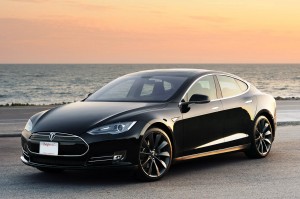 EVs have now been on the road in sizeable numbers for about five years though, so we’re starting to get some good data. And as Electrek reports, the news is pretty good, at least for Tesla batteries:
EVs have now been on the road in sizeable numbers for about five years though, so we’re starting to get some good data. And as Electrek reports, the news is pretty good, at least for Tesla batteries:
Data shows that the Model S’ battery pack generally only loses about 5% of its capacity within the first 50,000 miles and then the degradation significantly slows down with higher mileage. Plug-in America’s data shows several vehicles with over 100,000 miles driven and less than 8% degradation.
And anecdotally:
CEO Elon Musk once referred to a battery pack Tesla was testing in the lab. He said that the company had simulated over 500,000 miles on it and that it was still operating at over 80% of its original capacity.
This is all encouraging to hear, as that kind of degradation is relatively minor. And as noted, prices are coming down on batteries. It’s unclear if Tesla’s success though will translate to other EVs, as each company is using different chemistries and technologies. But the news on at least newer Nissans, for example, looks promising, too.
For some people it will take a lot more data like these to reassure them. So it’s nice to get some early returns and to see that the initial reports are generally positive. Otherwise, time will tell.
Battery electric transportation hasn’t seemed like a good fit for long-haul trucking. After all, the batteries are expensive and usually of limited range, while goods can be heavy and require sometimes multi-state routes. That’s why I’ve advocated for other clean fuel technologies like low-carbon biofuels and even hydrogen, if done right, for long-haul goods movement.
But maybe there is a solution for all-electric trucking: the tractor swap. As Green Car Reports covers:
The proposed tractor-swapping model calls for a truck with a nearly-depleted battery to pull into a station, where a fully-charged tractor would be waiting to pick up its trailer.
In a way, it’s similar to the current procedure of the Formula E electric-car racing series, where drivers swap cars mid-race.
Of course, companies have already tried battery swap for passenger electric vehicles, but gotten resistance from automakers who don’t like the most expensive asset in the vehicle tossed around by a third party. But the tractor part of a trucking operation is separable from the container, so this model could gain traction (no pun intended), particularly for relatively shorter shipping routes, such as out of the highly polluted ports in California like in Long Beach.
All in all, another example of the kind of innovation that this technology may unleash.
Most of the time I charge my electric vehicle, I do so at home, like most EV drivers. But every so often I venture far enough out where I need to charge publicly, and my experiences to date have not been great.
Recently I drove to San Jose and found a convenient charger on the street across from City Hall, looking like a newfangled parking meter. It was a ChargePoint charger, from one of the most successful charging companies in the state.
Yet ChargePoint, like other private charging companies, requires a membership to use their chargers. With a membership, I’d get a fob that I could swipe to unlock the charger and start charging.
Without a membership though, customers are forced to call a 1-800 number and place a special credit card order for one-time payments.
So that’s what I did. Standing on the sidewalk on my phone on hold for five minutes, before going through a laborious five-minute process confirming details (station ID number, my email address, visa card, etc.).
In this age of credit car readers everywhere, for some reason EV charging has not caught up. While I eventually did get a charge and in a convenient spot, there’s no reason to have that kind of transactional friction on something that should be so straightforward.
ChargePoint and other chargers should have credit card readers to make the process easy, and California should make that a requirement as part of all the public money they dole out to subsidize these machines.
One more idea to toss in the policy box to improve public charging in California.
There’s been a low-grade battle for the future of zero-emission vehicles in California. On one side are the well-known battery electric models, with companies like Tesla capturing the global imagination and state residents buying hundreds of thousands of vehicles to date.
On the other side are hydrogen fuel cell vehicles, capturing the imagination of…well, maybe a hundred buyers and a few state officials.
The problem is that the state is spending millions of dollars to subsidize both technologies, when many experts feel that hydrogen fuel cell vehicles will have very little role in the state’s transportation future.
Now Fred Lambert at Electrek observes that even the fuel-cell automakers are changing their tune:
I think we are witnessing the start of a new (but long overdue) trend this year. The few established automakers still pushing fuel cell hydrogen vehicles appear to be warming up to battery-powered electric vehicles instead. Honda, Toyota and Hyundai, arguably the automakers most stuck on hydrogen, all announced new electric vehicle programs in the past few weeks.
Toyota is working on a plug-in version of the Corolla. Hyundai is bringing its Ioniq electric platform to market by the end of the year and this morning, we reported on the Korea-based automaker developing a next generation battery-powered electric SUV.
Those two automakers are arguably the most entrenched in fuel cell technology with the Toyota Mirai, the Hyundai Tuscon Fuel Cell, and billions spent in investments between the two of them, but the most telling news is that Honda, another fuel cell believer, is planning to launch a battery-powered version of the Clarity, a car it actually developed for its fuel cell program.
Lambert notes the gaping inefficiencies of fuel-cell vehicles compared to battery electrics (which are almost three times more efficient, when accounting for the energy in versus the energy out), plus the greater complexity of the manufacturing/fuel supply process with fuel cells.
The only advantage hydrogen offers over battery electrics is refueling time. But as batteries eventually move to up to the 600-mile range in the coming decades, and as fast-charging technology improves, this benefit will diminish. Meanwhile, battery electrics have the contrary advantage of being able to fuel in your home and anywhere with an outlet, versus the need for the gas station model of hydrogen fueling.
To my mind, the only true benefit of hydrogen is for long-haul trucking (although biodiesel and other biofuels may be just as well-suited), and possibly as a form of energy storage, assuming the hydrogen is made from surplus renewables.
But I’m skeptical that automakers will truly abandon their fuel cell plans so quickly. My guess is it will be another five years or more before they truly get the message from the market.
With all the hype around Tesla’s Model 3, it’s easy to forget that Chevy is probably the first in line to deliver a 200-mile range electric vehicle for under $40,000. Now Motor Trend has the geeky details on the car:
The 60-kW-hr battery pack was co-developed with and is fully assembled by LG Chem in Korea. It employs 288 prismatic pouch cells (each 3.9 inches tall by 13.1 inches wide) that are curiously packaged in pairs but wired in three-cell groups. Their chemistry is similar to that used on the Spark EV but with a bit more nickel content to allow it to operate at a slightly higher temperature. The whole setup is considerably different from that of the extended-range Volt, as the Bolt requires energy-storage optimization whereas the Volt needs a balance between power delivery and energy storage. Capitalizing on copious lessons learned in the second-gen Volt and Spark EV, this battery holds more than triple the energy of the Spark EV battery pack (60.0 versus 18.4 kW-hrs) but weighs just over twice as much (961 versus 474 pounds).
The bottom line: the car will get you about the same range as the Model 3, but for probably a lot less money. This is because Chevy should still have enough $7500 federal tax credits to offer purchasers, whereas Tesla will have exhausted theirs by the time the Model 3 comes out.
But the performance of the Bolt will be nothing near a Model 3, as dual motor drive and therefore fast acceleration look to be impossible with the current Bolt battery configuration. In addition, the Bolt won’t have the fast-charge speed that Tesla offers, with about 90 mile range in 30 minutes being the best you could hope for. By comparison, Tesla offers 170 miles of range in the same charging time frame with their Supercharger network. So road trips will be slow in this vehicle.
Still, if range and price is what you care about, and not so much on performance, this vehicle will be a good option — and it should be available a lot sooner than the notoriously late Tesla.
Last month I summarized Republican front-runner Donald Trump’s views on various environmental issues. Since then, the candidate completed an environmental and energy questionnaire from the Koch-supported American Energy Alliance that sheds further light on his thinking, or at least where his thinking isn’t.
One thing that stood out is that he seems to have backed away from his desire to completely eliminate the U.S. Environmental Protection Agency. Instead, he wants more scrutiny:
Under my administration, all EPA rules will be reviewed. Any regulation that imposes undue costs on business enterprises will be eliminated.
Of course, EPA rulemaking already is required to take into account cost-benefit analyses in its major rules, but Trump answered affirmatively in the questionnaire that agencies have abused this analysis in order to give themselves more regulatory power.
On energy, he takes a position that may actually hurt the oil and gas industry:
Subsidies distort markets and should be used only when national security is at stake. Eventually, all subsidies should end so that the demand for energy will set prices, allow consumers access to the best values and encourage all facets of the energy industry to do all they can to keep their particular source competitive.
Ironically, the oil and gas industry receive significant subsidies from government, possibly close to $40 billion or more per year by some estimates. I’ve often thought of ending these subsidies as a sort of “dormant carbon tax,” because they could potentially raise the cost of oil and gas the way a carbon tax would.
But Trump seems to contradict himself somewhat in the next answer, where he says he favors subsidies if it means “energy independence.” He thinks that urgent need means “we must support all energy sources.” By that logic, he may be persuadable to support renewable energy and electric vehicles, although he rules out support for a carbon tax, which would be the most efficient way to boost energy independence and those clean technologies.
Trump also supports the renewable fuel standard (RFS) for the energy independence reason (although I’m sure Iowa politics played a role). He wants the RFS program to continue, although environmentalists don’t like the mandate because it doesn’t have an environmental screen on what fuel is produced. But that policy is actually an important backstop for California’s low-carbon fuel standard, which does have that screen (not that it’s a reason to keep the federal program as-is).
Trump went on to give muddled and confused answers on what the U.S. government should do with the federal land it owns (establish “a shared governance structure” with states) and on clean water (it’s the “responsibility of all citizens and governments” and “shared governance of waterways seems a logical way to go”).
Overall, a bit more of a window into the candidate’s thinking on issues. But these bits and pieces are all we’re likely to get at this point, given how little substance is on his website on environmental topics.

